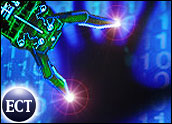
There may not be a white lab coat big enough for Adam, the newest and most expensive member of the scientific department at Aberystwyth University in Wales, UK.
Adam, a US$1 million robot-computer amalgam about the size of a large pickup truck, carried out genetic experiments on yeast and reached groundbreaking conclusions without human help, according to a report in the journal Science. That is, the robo-scientist set a hypothesis, carried out experiments, studied the results, and modified its original hypothesis based on what it had found.
Adam’s flesh-and-blood counterparts have confirmed that the robot did indeed discover something new about yeast genetics.
This major step toward reasoning machines and artificial intelligence is dominating the talk in scientific communities around the world Friday, and not just because of the potential job threat to low-paid human lab assistants and interns.
Speculation is rife over the possible implications for adding another pair of smart hands in a lab — even if those hands are silicon, not carbon-based.
A New Definition for ‘Robot’?
The loose way people use the term “robot” is one of Rich Hooper’s pet peeves; Hooper is a robotics consultant with Austin, Texas-based Symtx.
“People call everything a ‘robot’ — every machine you can think of — because it sounds sexy,” Hooper told TechNewsWorld. “All of these things are really automation, not robots.”
Adam, however, “seems like it’s kind of on the path of being a true robot in some ways,” he continued. “It’s evaluating options and choosing between them, and that’s more than just hard automation in a factory, where the machine just welds the same seam on the same door over and over.”
Adam’s development means science could rely more and more on artificial-intelligence-equipped robots to handle lab tasks that require adaptive thinking, not just menial or repetitive jobs. The scale of the lab work involved could be adjusted as well, to pack more experimentation in as technologies advance.
“Robotics are typically good for things that are monotonous or dangerous. [Scientists] are using lab automations that are kind of scaled to human size, but if the humans weren’t involved, then I could see the automations really shrinking. You could make things more compact, maybe faster.”
Data Mining and Pattern Recognition
There are two points to consider when discussing how other Adams could be used in science, according to Yoky Matsuoka, a Macarthur Award-winning professor of computer science and engineering at the University of Washington’s Neurobotics Lab.
“What human scientists are good at is seeing a large set of data and then inferring what’s going on, making the best judgments,” Matsuoka told TechNewsWorld. “Computers are quite good at machine learning [and] data mining — and in some cases, much better than humans in their ability to grasp large sets of data and come up with patterns in that data. I can easily imagine that AI would be superb in doing that over humans, and allowing robots to do that would be an excellent idea.”
However, Adam may never fully grasp the human experience, no matter how much his central processing units may benefit from Moore’s Law.
“When [humans] look at a tree, we immediately know it’s a tree, no matter what the tree looks like, whether it’s bent over or its leaves are yellow. We have the amazing ability to come up with abstract content that computers cannot do yet.”
Applications may exist for robo-scientists in medicine — where robotics is already gaining a foothold — that can take advantage of the combination of cybernetics and human brainpower, Matsuoka said.



















































